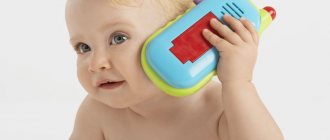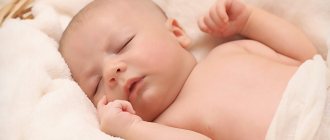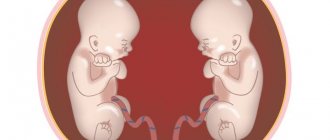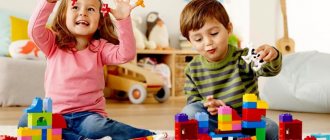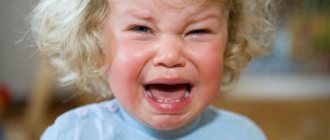The first year with a baby flies by almost unnoticed. Until recently, the child was a small lump, unable to independently hold his head, focus his gaze on a specific object, or pronounce syllables. Over the course of a year, the baby begins to understand a lot, pronounce the first words, learns to walk and continues to explore the world around him. How to determine that a child’s development is normal? What should you pay attention to? In this article we will talk about the characteristics of the physical and mental components of a one-year-old baby, and also teach how to properly promote further development.
Physiology of a child at 12 months - height and weight of a baby at 1 year
Starting from the age of 1, children's body proportions begin to change. The tummy becomes smaller, and the arms and legs lengthen. Each child gains weight and height individually.
According to WHO, the physiological parameters of one-year-old children lie within the limits:
| BOYS | GIRLS | |
| Height, cm | 74,0 — 79,5 | 73,0 – 78,0 |
| Weight, kg | 9,5 – 11,5 | 9,0 – 10,8 |
| Head circumference, cm | 43,2 – 48,5 | 42,0 – 47,5 |
What a child has learned by the age of 1: physical abilities of a one-year-old baby
By 12 months, the baby has learned a lot, as all children approach the one-year mark:
- They stand confidently without support.
- They take their first independent steps, and many already stomp quite confidently without the help of adults.
- They know how to use a spoon and drink from a cup.
- They get on and off the sofa or bed.
- Stand up from a sitting position without support.
- They confidently manipulate objects - build a house out of blocks, roll a ball or a car, rock a doll.
In addition, kids try to show independence in everything, which sometimes horrifies their parents . For example, if a baby gets his hands on his mother’s cosmetics, he will paint not only his lips or cheeks, but also everything that gets in his way.
Psychology of a one-year-old child: advice to parents of a 12-month-old baby
Since kids at this age are very active and inquisitive, parents are faced with the problem of how to teach the baby not to take what is not allowed. In any home there are many things that simply cannot be removed from a child’s reach.
If you try to fight your baby’s curiosity with prohibitions, you can achieve the opposite result. At this age, children are very stubborn and persistent. A child, if he is not allowed to touch something, will definitely break the ban and watch the reaction of adults.
Some tips on how to deal with a child who is, in the opinion of parents, naughty:
| What to do if your child takes prohibited things | In these cases, parents must be patient in order to calmly explain to the baby what not to do. Shouting and strict prohibitions will lead to a backlash. Only kindness and patience will help teach the baby to order . |
| Don't let your child do whatever he wants | The psychological state allows a one-year-old baby to be aware of the prohibitive intonations of his parents. However, mental development at this age lags behind psychology. The baby understands that he is prohibited from performing certain actions (for example, dumping porridge from a plate onto the table), but does not understand why this cannot be done. The parents’ task is to clearly and calmly explain to the child that there are things that cannot be done.. However, you should not be too zealous with prohibitions, cutting off at the root the child’s manifestation of independence. For every five “yes” you have, there should be no more than one “no”. |
| Let your baby play with safe objects | You cannot unconditionally forbid a child to touch anything that does not belong to his toys. The baby has become more mature, he is interested in everything that surrounds him. Learning new subjects contributes to the full and harmonious development of the baby . In any home there are things that he can play with without harming his health. This will give your child no less pleasure than playing with his favorite toys. |
| Don't yell at your baby | Try never to raise your voice at the little man, even if he has done something wrong. This will negatively affect the baby's psyche. In addition, children quickly adopt the actions of adults. A little time will pass, and the baby will begin to raise his voice at you. Therefore, be patient and become a worthy example for your child . |
| Talk to your child more | The development of the child's psyche of a one-year-old child is greatly influenced by communication with loved ones. The more you talk to your baby, the richer his still passive vocabulary will be , the faster he will begin to pronounce his first full words. A child who lacks communication may develop serious psychological problems. |
| Don't compare your baby with other children | Never compare your child with other children or adults in his presence , even if your assessment is aimed in favor of the baby. The baby will quickly understand that he is being evaluated, and may lose confidence not only in himself, but also in parental love. Over time, this can develop into an inferiority complex. |
| Show your baby how much you love him | Don't be afraid to spoil your baby with a show of your love . At this age, for psychological comfort, the baby must be surrounded by the care and love of loved ones. This does not mean that the baby can be allowed to do whatever he wants. Just praise, hug and kiss your baby more often. Psychologists say that a child’s self-awareness is formed at the age of one. Now the little man’s opinion of himself is based on how others treat him. |
| Remember that your baby is still small and defenseless | At the age of 10-12 months, physical development is significantly ahead of the psychological component. Remember that even the healthiest and most active child remains psychologically defenseless without the love of people close to him . Only parents with their attention and care can support the baby in any situation. |
Features of the development and upbringing of children in the first year of life material
The main developments of infancy are grasping and walking. At approximately 5 months, a turning point occurs in the child’s development; it is associated with the emergence of the act of grasping—the first organized, directed action. Initially, the child’s hand is clenched into a fist. Until the hand has become an organ of perception, it cannot become an organ of grasping. Grasping is carried out under the control of vision: the child examines his hands, watches how the hand approaches the object.
The act of grasping is of extreme importance for the mental development of a child, as perception is actively developing. Based on the act of grasping, the possibilities of manipulating an object expand, and at the age of 4 to 7 months, effective actions arise: simply moving an object, moving it, extracting sounds from it. At the age of 7 - 10 months, correlated actions are formed: the child can manipulate two objects at the same time, moving them away from himself and correlating them with each other. By the end of infancy (10 - 11 to 14 months), a stage of functional actions arises: these are more advanced actions of stringing, opening, inserting, now the child is trying to reproduce the action on all possible objects.
Grasping, directing towards an object stimulates the appearance of sitting - when the child sits down, other objects open up in front of him. Objects appear that cannot be touched. A pointing gesture appears from a hand extended to an unattainable object.
People surrounding the baby help him in everything from birth. They provide physical care for the child’s body, teach, educate him, contribute to the acquisition of human psychological and behavioral traits, and adaptation to the conditions of social existence. Support for a child from parents and adults begins at birth and continues for at least a decade and a half until the child becomes an adult and is able to lead an independent, self-sufficient lifestyle.
The first object that a child identifies from the surrounding reality is a human face. Maybe this happens because this irritant is most often located next to the child at the most important moments of satisfying his organic needs. The child's eyes, which for the first time begin to converge on the mother's face, and the smile on the mother's face serve as indicators of the selection of the object.
From the reaction of concentration on the mother's face, an important new formation of the newborn period arises - the revitalization complex. The revitalization complex is an emotionally positive reaction that is accompanied by movements and sounds. Before this, the child’s movements were chaotic and uncoordinated. The complex develops coordination of movements. The revival complex is the first act of behavior, the act of distinguishing an adult. This is also the first act of communication. The revival complex is not just a reaction, it is an attempt to influence an adult.
The revitalization complex is another major neoplasm of the critical period. It marks the end of the newborn and the beginning of a new stage of development - the stage of infancy. Therefore, the appearance of the revival complex represents a psychological criterion for the end of the neonatal crisis. The physiological criterion for the end of the newborn period is the appearance of visual and auditory concentration, the possibility of the appearance of conditioned reflexes to visual and auditory stimuli. The medical criterion for the end of the neonatal period is that the child has regained the original weight with which he was born, which indicates that the physiological systems of life are functioning normally.
Babies' thinking also develops. By the end of this age, children develop manual intelligence, or visual-effective thinking, which is built on the basis of trial and error and is associated with the development of the first independent movements. The development of orientation—reactions to new objects, the desire to examine them—is also of great importance.
Speech also develops, primarily passive - the child listens and distinguishes sounds. In the first half of the year, speech hearing is formed, and the child himself, with joyful animation, makes sounds, usually called humming. In the second half of the year, babbling appears, in which some repeating sound combinations can be distinguished. By the end of 1 year, the child understands 10 - 20 words spoken by adults, and he himself pronounces one or several of his first words, similar in sound to the words of adult speech. Another major new development of this age is the appearance of the first word. The peculiarity of the first words is that they are in the nature of pointing gestures. Speech, like all new developments of age, is transitional in nature. This is an autonomous, situational, emotionally charged speech, understandable only to those close to you.
Communication during this period should be emotionally positive. This creates an emotionally positive tone in the child, which serves as a sign of physical and mental health.
Development of a one-year-old child - what a baby is capable of at 12 months
For the correct development of the baby, the choice of activities and games appropriate to his age, you need to pay attention to his preferences and needs in order to create an atmosphere favorable for the full development of the child.
- The baby moves a lot . At the age of one, children who have begun to walk love to move around the entire apartment, carrying something in their hands. In addition, the baby enjoys climbing onto a chair or sofa, sitting down and standing up, and playing while sitting on the floor or squatting. Provide your baby with safe, free space to move around. The floor should be non-slip or carpeted, securely supported by furniture. Provide your baby with a comfortable corner for games; it should not be in the middle of the room and interfere with the passage.
- Hide and seek games . Almost all children at this age like to hide or look for things that have disappeared from sight. Spend at least a little time on this game every day, each time finding a new secret place.
- Kids toys . A child’s arsenal must include educational toys that promote comprehensive development, as well as games for fine motor skills. Many children prefer things that, in general, are not intended for play, to the most colorful toys. Bags with pockets, empty boxes or drawers are very interesting for kids. They can fill empty containers with toys and other objects for quite a long time, and then empty them again. Don't deprive your kids of this pleasure!
- We copy the actions of adults . Since at the age of one, the baby actively copies all the actions of adults, he will happily play with a doll that needs to be put to bed, combed, or fed, cook dinner in a toy dish, or call dad at work from his phone. All children enjoy playing with objects that can be carried or pushed - cars or various gurneys with rotating elements.
Raising children from 1 year. Games
At the same age, children's games become more figurative in nature. Show your child how to build a house from blocks, a train or a tower. By the end of the second year of life, the baby can already start playing with sand. Teach him to pour water into a bucket and make sand pies.
Children who will soon turn two years old are showing interest in books. You shouldn’t literally “overwhelm” your child with a huge number of books. It is enough if it is two or three books with bright colorful pictures.
Be sure to read these books to your child, show all the main characters in the pictures. Then he himself will “read” his favorite fairy tales in his children’s language, it is quite possible that the book may be upside down.
The most important thing is that classes with the child are systematic. Children with whom someone works every day develop much faster, and in this case not only imitative actions are actively formed, but also speech.
But even in this case, observe moderation: excessive loads, a huge number of toys, many “adult teachers” lead to the opposite effect - a delay in the development of the baby’s speech.
Caress your baby, but without fanaticism, as caressing leads to the development of selfishness. Punishment is also a very important aspect of education. In this case, there are many methods. Under no circumstances use beating or methods that degrade the child’s dignity, such as insulting or kneeling.
Cultivate positive qualities with affection, and with punishment an understanding of what is prohibited. Be strict but fair parents.
The wrongness of adults and unfair punishment greatly hurt the child’s soul and contribute to the emergence of a number of complexes.
Crisis of the baby's first year: how to survive a difficult period with a one-year-old child
Most modern parents have heard or know about the crisis of a child at the age of 1 year. At this time, the baby’s behavior changes, he is often capricious and cries, and becomes more demanding and stubborn. When asked to do something, the baby categorically refuses. Parents often wonder why a healthy, happy child living in a prosperous family experiences some kind of incomprehensible crisis.
Psychologists explain that a crisis in young children is an integral part of growing up and developing the personality of a little person.
At the age of 12 months, children are faced with a conflict of their own interests. The child has a desire to perform some action (to go somewhere, to get something), but there is no opportunity to realize his needs.
Experts in the field of psychology do not consider the crisis of 1 year of life as a negative phenomenon. After all, it is in the process of overcoming difficulties that a child’s personality is formed.
Dissatisfaction with the current situation stimulates the development of the baby. When a baby tearfully refuses mom or dad’s help in one matter or another, he is in conflict not with his parents, but with the world around him.
Adults need to be patient and not scold or punish the child for violent manifestations of character. A friendly and calm environment in the family mitigates the problems that arise for the baby.
Very little time will pass, he will master new skills and there will be no trace of the crisis left.
Early development of children. Developmental activities for one-year-olds
Walking
If your child is in no hurry to take his first steps and continues to crawl enthusiastically, attract him with his favorite toy . There are children who have a fear of losing their balance, and a toy will help them cope with it. If possible, allow your baby to walk barefoot on sand, grass or dirt.
Gross motor stimulation
Offer games with large toys: balls, cars, etc.
Development of fine motor skills
Attach clothespins to the edge of the jar and show your baby how to remove them. Exercises with cereals, water and sand are useful.
Speech
In order for the child to remember as many new words as possible, you need to talk to him a lot . Tell him about your surroundings and explain all your actions.
Story games
When playing with your child, allow him to do things on his own that he can do. Play simple story games: give a bear a bath, feed a bunny, give a doll a ride in a car, etc.
Music
Play music of various genres , play nature sounds. This way you will stimulate your baby’s hearing development well.
Drawing and sculpting
The first drawings are best done using finger paints or crayons . Children love to smear paint onto paper with their hands. They also enthusiastically sculpt from salt dough or plasticine . Even if the result is not quite what you might expect, the process of creation itself will be very interesting for the child.
Sandbox
Before going to the sandbox, get a small set : a scoop, a rake, a bucket, a sieve and 1-2 molds. No more. In the sand, offer each item to the child in turn, clearly showing how it can be used.
Playing with shadows
In sunny weather, pay your baby's attention to your shadow and his. Move, indicating that the shadow is also moving. Offer to step on your shadow.
Communication with other children
If the toddler does not have brothers and sisters, you can always find a company of mothers and babies in the yard. Walk together, visit each other. Communication with other children is very important.
Photo album
Keep an album in which photographs of loved ones and pictures of animals will be stored. The child will look at them for a long time.
Reading
Spend some time every day reading nursery rhymes and short fairy tales. To do this, it is better to purchase books with hard pages and bright pictures. Let your little one decide for himself which book you will start reading.
Bathing with toys
rubber toys in the bathtub . Give your child a sieve and demonstrate how you can use it to catch floating objects and put them in a bucket.
